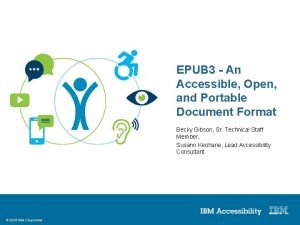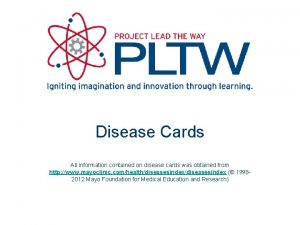Disease Cards All information contained on disease cards





![Creutzfeldt-Jakob Disease (CJD) [AKA Mad Cow Disease] Type of Infectious Agent Prion (Diseased protein Creutzfeldt-Jakob Disease (CJD) [AKA Mad Cow Disease] Type of Infectious Agent Prion (Diseased protein](https://slidetodoc.com/presentation_image_h2/fd12b5df2ae09e0434ef4b4b6e665483/image-6.jpg)






- Slides: 12

Disease Cards All information contained on disease cards was obtained from http: //www. mayoclinic. com/health/diseasesindex (© 1998 -2012 Mayo Foundation for Medical Education and Research) Principles of Biomedical Science © 2013 Project Lead The Way, Inc.

Tuberculosis (TB) Type of Infectious Agent Bacteria (Single cell prokaryotic organism) Name of Infectious Agent Mycobacterium tuberculosis Symptoms of Disease Usually, TB bacteria grow in the lungs where they cause a bad cough that lasts 3 weeks or longer, pain in the chest, and coughing up blood or the phlegm from deep inside the lungs. Other symptoms include weakness, fatigue, weight loss, no appetite, chills, fever, and sweating at night. Diagnosis of Disease Skin test, blood test, chest X-ray, and sputum culture. Transmission of Disease TB is spread through the air from one person to another. The TB bacteria are put into the air when a person with TB disease of the lungs or throat coughs, sneezes, speaks, or sings. People nearby may breathe in these bacteria and become infected. Treatment of Disease Antibiotic treatment

Strep Throat Type of Infectious Agent Bacteria (Single cell prokaryotic organism) Name of Infectious Agent Streptococcus pyogenes Symptoms of Disease General symptoms include throat pain, difficulty swallowing, red and swollen tonsils that often have white patches or streaks of pus on them, tiny red spots on the soft or hard palate, swollen and tender lymph nodes in the neck, fever, headache, rash, and fatigue. Diagnosis of Disease Throat culture, and/or rapid DNA test. Transmission of Disease Streptococcal bacteria are highly contagious. They can spread through airborne droplets when someone with the infection coughs or sneezes, or through shared food or drinks. You can also pick up the bacteria from a doorknob or other surface and transfer them to your nose or mouth. Treatment of Disease Oral antibiotic treatment with penicillin, amoxicillin, erythromycin, or azithromycin.

Giardiasis Type of Infectious Agent Protozoa (single cell eukaryotic organism) Name of Infectious Agent Giardia lamblia parasite Symptoms of Disease A gastrointestinal disease with water, sometimes foul-smelling diarrhea that may alternate with soft, greasy stools, fatigue, abdominal cramps and bloating, belching gas with a bad taste, nausea, and weight loss. Diagnosis of Disease The infection is diagnosed with a stool sample. Transmission of Disease Giardia parasites live in the intestines of people and animals. Before the microscopic parasites are passed in stool, they become encased within hard shells called cysts, which allows them to survive outside the intestines for months. Once inside a host, the cysts dissolve and the parasites are released. Infection occurs when you accidentally ingest the parasites. This can occur by swallowing contaminated water, by eating contaminated food, or through person-to-person contact. Commonly in dogs that drink stream water. Treatment of Disease Administration of antibiotic or anti-parasite medications specific to giardia infection (including metronidazole, tinidazole, nitazoxanide, and paromomycin).

Malaria Type of Infectious Agent Protozoa (single cell eukaryotic organism) Name of Infectious Agent Plasmodium parasite Symptoms of Disease Malaria causes damage to red blood cells which can cause serious and sometimes fatal complications. The disease is characterized by recurrent attacks with moderate to severe flu-like symptoms, including shaking, chills, high fever, profuse sweating as the body temperature falls, headache, nausea, vomiting, and diarrhea. Diagnosis of Disease Blood test for the parasite. Transmission of Disease Malaria is a microscopic parasite transmitted from person to person via a biological vector, which is something living carrying a diseases from one person to another person, but never being harmed by the disease themselves. In the case of malaria, a mosquito becomes infected by feeding on a person who has malaria and then transmits the malaria parasites to the next person the mosquito bites. Malaria can also be transmitted from mother to unborn child, through infected blood transfusions, and by sharing infected needles. Treatment of Disease Administration of antimalarial drugs.
![CreutzfeldtJakob Disease CJD AKA Mad Cow Disease Type of Infectious Agent Prion Diseased protein Creutzfeldt-Jakob Disease (CJD) [AKA Mad Cow Disease] Type of Infectious Agent Prion (Diseased protein](https://slidetodoc.com/presentation_image_h2/fd12b5df2ae09e0434ef4b4b6e665483/image-6.jpg)
Creutzfeldt-Jakob Disease (CJD) [AKA Mad Cow Disease] Type of Infectious Agent Prion (Diseased protein that causes other healthy proteins to transform into diseased proteins) Name of Infectious Agent CJD Prion Symptoms of Disease CJD is marked by rapid mental deterioration, usually within a few months. Initial signs and symptoms typically include personality changes, anxiety, depression, memory loss, impaired thinking, blurred vision, insomnia, difficulty speaking, difficulty swallowing, and sudden jerky movements. As the disease progresses, mental symptoms worsen and people eventually lapse into a coma and die. Diagnosis of Disease Doctors commonly use an EEG, MRI, spinal fluid tests, and/or tonsil biopsies to diagnose the disease. Transmission of Disease CJD disease is caused by an abnormal version of a kind of brain protein called a prion. Normally the proteins are harmless, but when they’re misshapen they become infectious and can cause major problems on normal biological processes. Most people with CJD spontaneously develop the disease for no apparent reason, but others who develop the disease have a family history of the disease or test positive for a genetic mutation associated with CJF. A small number of people have developed CJD after being exposed to infected human tissue during a medical procedure. This happens because standard sterilization methods do not destroy abnormal prions. In the case of Mad Cow Disease, diseased nerve tissue (such as brain) must be eaten. If cows are infected and not properly slaughtered the meat may have some brain contamination. Cooking the meat will NOT get rid of the prion. When a person consumes the meat they become infected by the disease. Treatment of Disease In the past, in some cultures it was customary to eat the brain of a deceased family member, to allow them “live on. ” If the deceased died of CJD, then everyone that consumed the brain becomes infected with the disease and dies as well. These cultures became extinct. No effective treatment exists for Creutzfeldt-Jakob disease or any of its variants. CJD IS EXTREMELY RARE AND VERY LITTLE IS KNOWN ABOUT THIS DISEASE AND NEEDS TO BE STUDIED MORE BY MEDICAL SCIENTIESTS.

Trichinosis Type of Infectious Agent Helminth (Worm) Name of Infectious Agent Trichinella roundworm Symptoms of Disease When a person swallows trichinella larvae encased in a cyst, the digestive juices dissolve the cyst, releasing the parasite into the body. The larvae then penetrate the intestine, where they mature into adult worms and mate. At this stage, symptoms include diarrhea, abdominal cramps, and malaise. Later the adult female worms produce larvae that penetrate the intestinal wall, enter the bloodstream, and burrow into muscle or other tissue. This causes high fever, muscle pain and tenderness, swelling of the eyelids or face, weakness, headache, and sensitivity to light. Diagnosis of Disease Initial diagnosis relies on physical examination of the classic signs and symptoms, blood samples, and a muscle biopsy. Transmission of Disease People get trichinosis when they eat undercooked meat — such as pork, bear, walrus, or horse — that is infected with the immature form (larvae) of the trichinella roundworm. Treatment of Disease Administration of anti-parasite (anti-helminthic) medication.

Tapeworm Type of Infectious Agent Helminth (Worm) Name of Infectious Agent Tapeworm Symptoms of Disease Intestinal infections cause nausea, weakness, loss of appetite, abdominal pain, diarrhea, weight loss and inadequate absorption of nutrients from food. Invasive infections result in fever, cystic masses or lumps, allergic reactions to the larvae, bacterial infections, and neurological symptoms including seizures. Diagnosis of Disease Stool sample analysis, blood test, and/or imaging exam. Transmission of Disease Consumption of food or water contaminated with feces from a person or animal with tapeworm or ingestion of larvae cysts in meat or muscle tissue of an animal with a tapeworm infection. Treatment of Disease Administration of oral medications that are toxic to the adult tapeworm (including praziquantel, albendazole, and nitazoxanide).

Common Cold Type of Infectious Agent Virus Name of Infectious Agent Rhinovirus Symptoms of Disease Symptoms include: runny or stuffy nose, itchy or sore throat, cough, congestion, slight body aches or a mild headache, sneezing, watery eyes, a low-grade fever, and mild fatigue. Diagnosis of Disease Physical examination. Transmission of Disease The virus enters your body through your mouth or nose. The virus can spread through droplets in the air when someone who is sick coughs, sneezes, or talks. But it also spreads by hand-to-hand contact with someone who has a cold or by using shared objects, such as utensils, towels, toys, or telephones. If you touch your eyes, nose, or mouth after such contact or exposure, you're likely to "catch" a cold. Treatment of Disease There is no cure for the common cold. Over-the-counter cold treatments do not treat the cold but can sometimes relieve symptoms. These include pain relievers, decongestants, and cough syrups.

Flu Type of Infectious Agent Virus Name of Infectious Agent Influenza Symptoms of Disease Symptoms include fever, aching muscles (especially in the back, arms, and legs), chills and sweats, headache, dry cough, fatigue and weakness, and nasal congestion. Diagnosis of Disease Physical examination. Transmission of Disease Flu viruses travel through the air in droplets when someone with the infection coughs, sneezes, or talks. You can inhale the droplets directly, or you can pick up the germs from an object — such as a telephone or computer keyboard — and then transfer them to your eyes, nose, or mouth. Treatment of Disease Bed rest and hydration is usually the only treatment needed. Antiviral medications can be prescribed if taken soon after symptoms begin. These drugs may shorten the illness by a day or so and help prevent serious complications.

Ringworm (Tinea corporis) Type of Infectious Agent Fungus Name of Infectious Agent Dermatophytes Symptoms of Disease A circular rash on the skin that’s red and inflamed around the edge and healthy looking in the middle; slightly raised expanding rings of red, scaly skin on the trunk or face; and/or a round, flat patch of itchy skin. Diagnosis of Disease Skin scrapings or samples from the infected area are taken and looked at under a microscope. Transmission of Disease Ringworm is contagious and can be spread in the following ways: direct, skin-to-skin contact with an infected person; touching an animal with ringworm; contact with objects or surfaces that an infected person or animal has recently touched or rubbed against; or contact with infected soil. Treatment of Disease Administration of a prescription-strength topical antifungal or oral medication.

Athlete’s Foot (Tinea pedis) Type of Infectious Agent Fungus Name of Infectious Agent Dermatophytes Symptoms of Disease Symptoms include itching, stinging, and burning between the toes; itching, stinging, and burning on the soles of the feet; itchy blisters; cracking and peeling skin, especially between the toes and on the soles of the feet; excessive dryness of the skin on the bottoms or sides of the feet; and/or toenails that are thick, crumbly, ragged, discolored, or pulling away from the nail bed. Diagnosis of Disease Skin scrapings or samples from the infected area are taken and viewed under a microscope. Transmission of Disease Athlete's foot thrives in thick, tight shoes that squeeze the toes together and create warm, moist areas between them. Damp socks and shoes and warm, humid conditions also favor the organisms' growth. The fungus is transmitted by sharing clothes or shoes with someone who has the fungal infection or walking barefoot in public areas where the infection can spread. Treatment of Disease Administration of antifungal medication.
 The newspaper report contained important information
The newspaper report contained important information The source card
The source card Name all the lines name all the segments name all the rays
Name all the lines name all the segments name all the rays Communicable disease and non communicable disease
Communicable disease and non communicable disease The presence of coal in antarctica indicates that
The presence of coal in antarctica indicates that Which rigid cylinder contains the same number
Which rigid cylinder contains the same number Why must an arcing device be contained
Why must an arcing device be contained Which colonial region contained rocky soil and cold climate
Which colonial region contained rocky soil and cold climate Earths early atmosphere contained
Earths early atmosphere contained Contained rock asphalt mat
Contained rock asphalt mat Epub contained by
Epub contained by Self contained regime
Self contained regime Figures of speech in animals class 10
Figures of speech in animals class 10






















